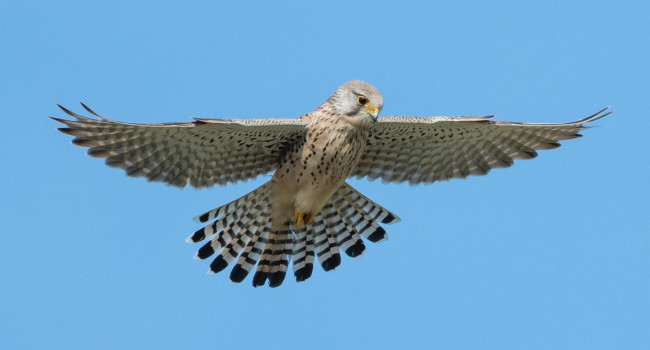Sparrowhawk

Accipiter nisus
The Sparrowhawk is a raptor well-adapted for hunting small birds in wooded areas. As such, it has rather short rounded wings and a long square-ended tail, both of which help it to manoeuvre through woodland in pursuit of its favoured prey. The plumage is grey or brown above and the underside has horizontal barring. Unlike the Kestrel, the Sparrowhawk does not hover but prefers instead to use the available cover as it comes dashing through the garden after small birds.
Sparrowhawks feed on other birds. This brought them into conflict with people rearing gamebirds, particularly where large numbers of pheasants were released into a wood, and Sparrowhawks were controlled. They were also hit by the effects of organochlorine pesticides. Since these were banned (and since legal protection has been better enforced in the countryside), the population has begun to recover.
This recovery has enabled Sparrowhawks to exploit our gardens in the search for food. Seeing your favourite Blackbird or Robin taken by a Sparrowhawk can be very distressing, but it is worth remembering that this is a natural process, exactly the same as a Blackbird feeding on worms or a Blue Tit taking caterpillars - it is part of a natural system. Because it is a natural system, there is a balance that occurs, the predators regulating the number of small birds and the availability of small birds influencing the number of Sparrowhawks. Because of this, it is extremely unlikely that Sparrowhawk predation could be behind the long-term decline of songbirds that we have seen. Most evidence points to the human-driven changes in the countryside as the cause of these declines.
Sparrowhawks suffered as a result of the use of DDT. When DDT and other organochlorine pesticides were first used, they were viewed as a wonderful tool within agriculture, partly because a single application lasted for such a long time. Unfortunately, these compounds were found to persist in the food chain and to accumulate in animals at the top of the food chain (like Sparrowhawks and Peregrine Falcons). These compounds influenced the reproductive output of Sparrowhawks by reducing the thickness of the eggshells. These in turn were more likely to break while the female was incubating and the population of Sparrowhawks crashed.
Find out more about Sparrowhawks on BirdFacts and the Wider Countryside Report.






Share this page